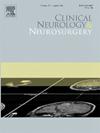颅内巨大动脉瘤7年单中心回顾性治疗策略及临床结果分析
IF 1.8
4区 医学
Q3 CLINICAL NEUROLOGY
引用次数: 0
摘要
巨大颅内动脉瘤(GIA)的尺寸≥ 25 mm,是一种罕见的、具有挑战性的疾病,预后较差。选择合适的治疗方法,无论是手术、血管内治疗还是两者结合,对于获得良好的结果至关重要。然而,每种GIA的独特特征意味着没有单一的治疗方案可以被认为是普遍最佳的。本研究旨在评估本中心的治疗策略和临床结果。方法本回顾性、单中心研究于2012年至2018年进行,纳入了20例GIA患者。我们全面回顾了人口统计学、动脉瘤特征、临床和影像学资料、治疗策略、血管造影和临床结果。结果平均最大GIA为29.4 mm(不含蛇纹石)。12个动脉瘤位于颈内动脉(ICA);三、大脑前动脉;第五,大脑中动脉。形态学上观察到囊状动脉瘤18个,蛇形动脉瘤2个。其中有症状者14例,蛛网膜下腔出血8例,其中伴有脑出血5例(62.5 %)。在5例ICA动脉瘤中观察到颅神经相关症状,其中2例累及颈动脉海绵窦瘘。5例多发性动脉瘤伴GIA。治疗方式多种多样;8名患者最初接受了手术治疗。治疗步骤数方面,1步14例,2步4例,3步2例。在8例患者中,母动脉闭塞(伴或不伴搭桥手术)是最终的治疗方法。1年后,70 %的患者获得了良好的结果,如修改的Rankin量表评分≤ 2所示。结论个体化治疗是提高临床疗效的关键。由于新设备的发展,血管内治疗取得了进步。母动脉闭塞与血管搭桥是一种可靠的治疗选择。本文章由计算机程序翻译,如有差异,请以英文原文为准。
A 7-year retrospective single-center study on treatment strategy and clinical outcome of giant intracranial aneurysm
Background
A giant intracranial aneurysm (GIA) measures ≥ 25 mm and is a rare, challenging condition to treat with a poor prognosis. Selecting the appropriate treatment approach, whether surgical, endovascular, or a combination of both, is crucial for achieving favorable outcomes. However, the unique characteristics of each GIA imply that no single treatment option can be considered optimal universally. This study aimed to evaluate the treatment strategies and clinical outcomes at our center.
Methods
This retrospective, single-center study conducted between 2012 and 2018, included 20 patients with GIA. We comprehensively reviewed demography, aneurysm characteristics, clinical and radiography data, treatment strategies, and angiography and clinical outcomes.
Results
The average maximum GIA was 29.4 mm (excluding serpentine). Twelve aneurysms were located in the internal carotid artery (ICA); three, anterior cerebral artery; and five, middle cerebral artery. Morphologically, 18 saccular and 2 serpentine aneurysms were observed. Among them, 14 were symptomatic, with 8 presenting with subarachnoid hemorrhage, of which, 5 (62.5 %) were accompanied by intracerebral hemorrhage. Cranial nerve–related symptoms were observed in five ICA aneurysms, and two involved a carotid cavernous fistula. Five patients had multiple aneurysms accompanied by GIA. The treatment modalities varied; eight patients initially underwent surgical treatment. Regarding the number of treatment steps, 14 patients required one step, 4 required two steps, and 2 required three steps. In eight patients, parent artery occlusion (with or without bypass surgery) was the final treatment approach. After 1 year, 70 % of patients achieved a favorable outcome, as indicated by a modified Rankin Scale score ≤ 2.
Conclusions
Patient-specific treatments are crucial for improving clinical outcomes. Advancements in endovascular treatment have been made owing to the development of new devices. Parent artery occlusion with vascular bypass was a reliable treatment option.
求助全文
通过发布文献求助,成功后即可免费获取论文全文。
去求助
来源期刊

Clinical Neurology and Neurosurgery
医学-临床神经学
CiteScore
3.70
自引率
5.30%
发文量
358
审稿时长
46 days
期刊介绍:
Clinical Neurology and Neurosurgery is devoted to publishing papers and reports on the clinical aspects of neurology and neurosurgery. It is an international forum for papers of high scientific standard that are of interest to Neurologists and Neurosurgeons world-wide.
 求助内容:
求助内容: 应助结果提醒方式:
应助结果提醒方式:


